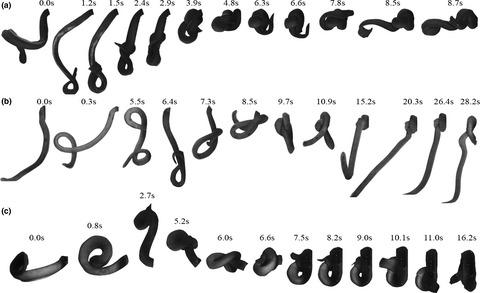Our official English website, www.x-mol.net, welcomes your feedback! (Note: you will need to create a separate account there.)
Characterization of body knotting behavior used for escape in a diversity of hagfishes
Journal of Zoology ( IF 2 ) Pub Date : 2019-12-29 , DOI: 10.1111/jzo.12752 W. A. Haney 1 , A. J. Clark 2 , T. A. Uyeno 1
Journal of Zoology ( IF 2 ) Pub Date : 2019-12-29 , DOI: 10.1111/jzo.12752 W. A. Haney 1 , A. J. Clark 2 , T. A. Uyeno 1
Affiliation

|
Hagfishes possess flexible bodies that allow them to tie and manipulate body knots. These knots are used to remove mucous from the body, escape tight spaces, pull prey from burrows and, since they lack opposable jaws, to create leverage during feeding events. Despite its importance, knotting is poorly understood because this fast and three‐dimensionally complex behavior is difficult to study both in the laboratory and in their natural benthic habitats. To consistently stimulate analyzable knotting behaviors, we developed a novel restraint device to record high‐speed, biplanar video in three species of hagfish from two major taxa (Eptatretinae and Myxininae): Eptatretus stoutii, Eptatretus springeri and Myxine glutinosa. These data were analyzed to characterize knot type and kinematics of knot formation. We found that despite reduced radii of curvature and strain associated with more complex knots, all species of hagfish preferred the simplest overhand knots. While all species were physically capable of tying more complex knots, E. stoutii exhibited a lower ‘behavioral’ stiffness by tying complex knots more frequently and coiling when at rest. The hyper‐flexible, hyper‐redundant hagfish body may require a high level of neural input for control. However, analyses of knotting motions indicate that hagfish seem to employ only four movements (body bends, twists, surface contacts and tail insertions into body loops) but in different combinations depending on the knot being tied. Furthermore, these movements and combinations are conserved across all species tested. We hypothesize that control of knotting in hagfish may employ motor primitives to reduce neural input.
中文翻译:

用于在各种g鱼中逃脱的身体打结行为的表征
g鱼具有灵活的身体,使它们能够系结和操纵身体的结。这些结可用于清除体内粘液,逃避狭窄的空间,从洞穴挖出猎物,并且由于它们没有相对的下巴,因此可以在进食期间发挥作用。尽管打结很重要,但由于在实验室及其自然底栖生境中都难以研究这种快速且三维复杂的行为,因此人们对其了解甚少。为了持续激发可分析的打结行为,我们开发了一种新颖的约束装置来记录来自两个主要分类群(Eptatretinae和Myxininae)的三种ha鱼的高速双平面视频:Sttaii,Eptatatretus springeri和Myxine glutinosa。分析这些数据以表征结类型和结形成运动学。我们发现,尽管曲率半径和应变半径减小了,但结节复杂了许多,但所有的ha鱼都更喜欢最简单的手结。尽管所有物种在物理上都能够打结更复杂的结,但E. stoutii通过更频繁地打结并在静止时盘绕,表现出较低的“行为”刚度。超柔韧性,超冗余的ha鱼体可能需要高水平的神经输入来进行控制。但是,对打结运动的分析表明,g鱼似乎只采用了四个运动(身体弯曲,扭曲,表面接触以及将尾巴插入身体环中),但根据打结的方式采用不同的组合。此外,这些运动和组合在所有测试物种中均得到保留。我们假设控制ha鱼的打结可能会采用运动原语来减少神经输入。
更新日期:2019-12-29
中文翻译:

用于在各种g鱼中逃脱的身体打结行为的表征
g鱼具有灵活的身体,使它们能够系结和操纵身体的结。这些结可用于清除体内粘液,逃避狭窄的空间,从洞穴挖出猎物,并且由于它们没有相对的下巴,因此可以在进食期间发挥作用。尽管打结很重要,但由于在实验室及其自然底栖生境中都难以研究这种快速且三维复杂的行为,因此人们对其了解甚少。为了持续激发可分析的打结行为,我们开发了一种新颖的约束装置来记录来自两个主要分类群(Eptatretinae和Myxininae)的三种ha鱼的高速双平面视频:Sttaii,Eptatatretus springeri和Myxine glutinosa。分析这些数据以表征结类型和结形成运动学。我们发现,尽管曲率半径和应变半径减小了,但结节复杂了许多,但所有的ha鱼都更喜欢最简单的手结。尽管所有物种在物理上都能够打结更复杂的结,但E. stoutii通过更频繁地打结并在静止时盘绕,表现出较低的“行为”刚度。超柔韧性,超冗余的ha鱼体可能需要高水平的神经输入来进行控制。但是,对打结运动的分析表明,g鱼似乎只采用了四个运动(身体弯曲,扭曲,表面接触以及将尾巴插入身体环中),但根据打结的方式采用不同的组合。此外,这些运动和组合在所有测试物种中均得到保留。我们假设控制ha鱼的打结可能会采用运动原语来减少神经输入。



























 京公网安备 11010802027423号
京公网安备 11010802027423号